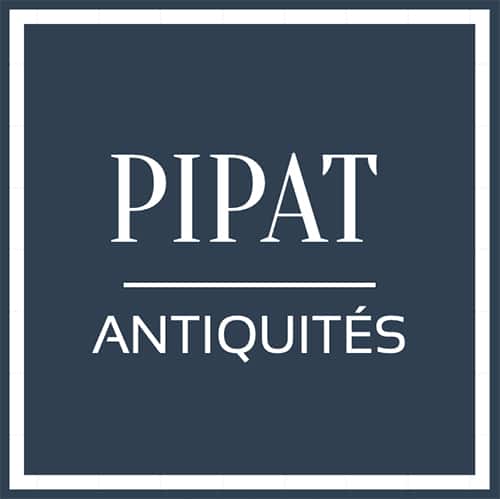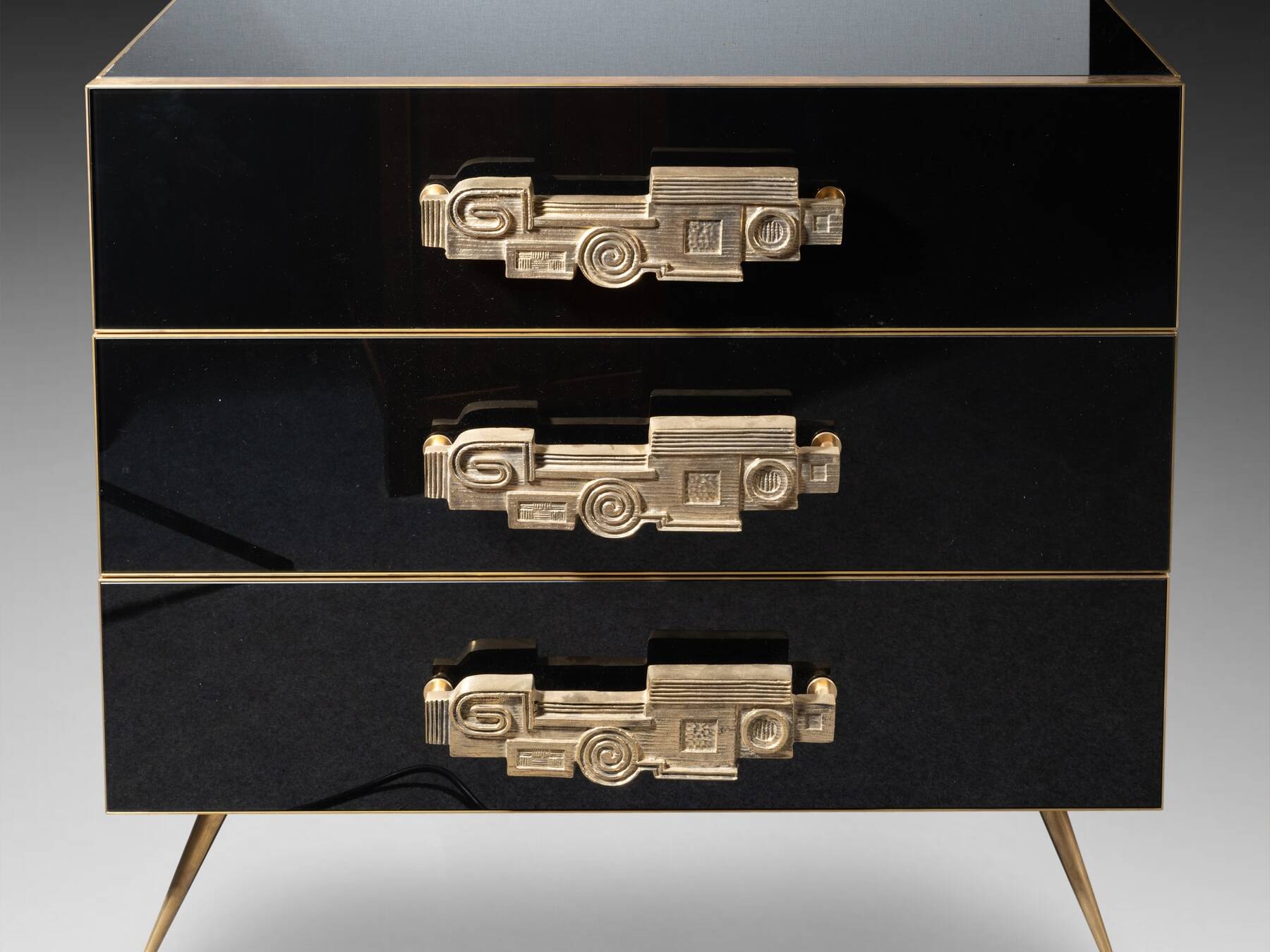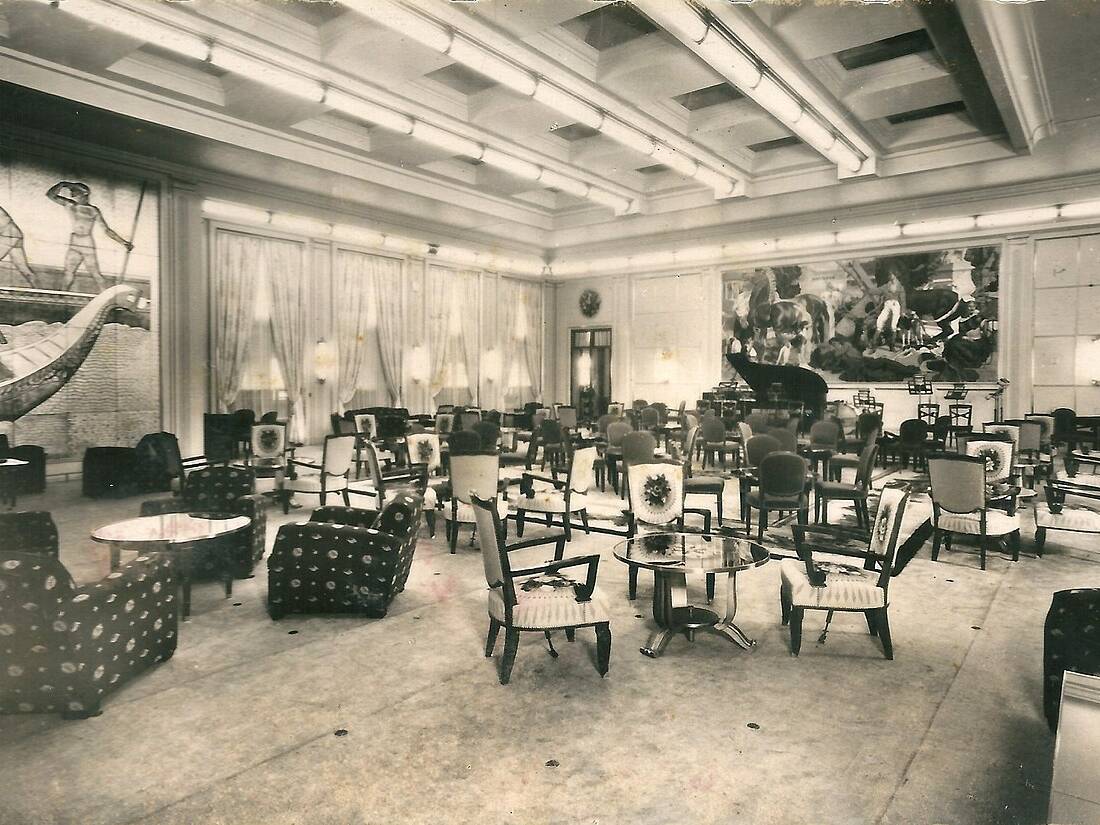Bringing together both the rich shimmer of mother-of-pearl and the elegance of a form intrinsically containing the golden ratio, the nautilus is an essential naturalia. These collections of natural curiosities, mixed with those made by human hands, were formed in Europe during the Renaissance and in some ways foreshadowed our contemporary museums. Humanist princes and scholars, dignitaries and representatives of the upper middle class gather in dedicated cabinets or eponymous furniture, fabulous collections where all sorts of works or curiosities are haphazardly mixed, paying homage to the genius of Man or to that of Nature and, always, to divine creation.
Between admiration, beliefs, ostentation and erudition, the French cabinet of curiosities, the German wunderkammer or the Italian studiolo work to highlight the nautilus which is then at the junction of mathematical discoveries (in 1587, Jost Bürgi (1552 – 1632) – watchmaker, designer of measuring instruments, astronomer and Swiss mathematician – made himself the precursor of the logarithmic calculation making it possible to account geometrically for the spiral of shells) and the first great voyages of exploration, superstitions prophylactics and secrets of artistic compositions.
Nautilus: works of art with a special status
Their origin, their substantial size or the beauty of their mother-of-pearl are all reasons for the desire of these nautiluses caught in distant seas. Haloed by the exotic mystery that accompanies the first great explorations of the Pacific, these shells have been part of the most famous cabinets of curiosities of the Old Continent since the 16th century.
Beforehand, the shell is sanded then polished in order to release the pearly layer. The latter revealing remarkable iridescent reflections, the artists were not long in adorning it or enhancing it in increasingly virtuoso pieces. However, the nautiluses, objects of curiosities and study of the world and the wonders it conceals, do not switch only to the side of the aesthetic object once encased in precious mounts.
As the art historian Sabine du Crest points out, “While one might have feared that scholarly work would strip the naturalia of their exoticism, the opposite has actually happened in European consciousness. The strangest or most surprising – even the most disturbing – naturalia were in fact almost immediately assimilated to works of art and presented in cabinets of curiosities because of their strangeness. » (in Sabine du Crest, « Reliquaries of a new genre », The conference proceedings of the musée du quai Branly Jacques Chirac [Online]). [En ligne]).
Their value is therefore much higher than that of a simple curiosity, and is doubly a work of art once the nautilus has been worked by the hand of the artist.
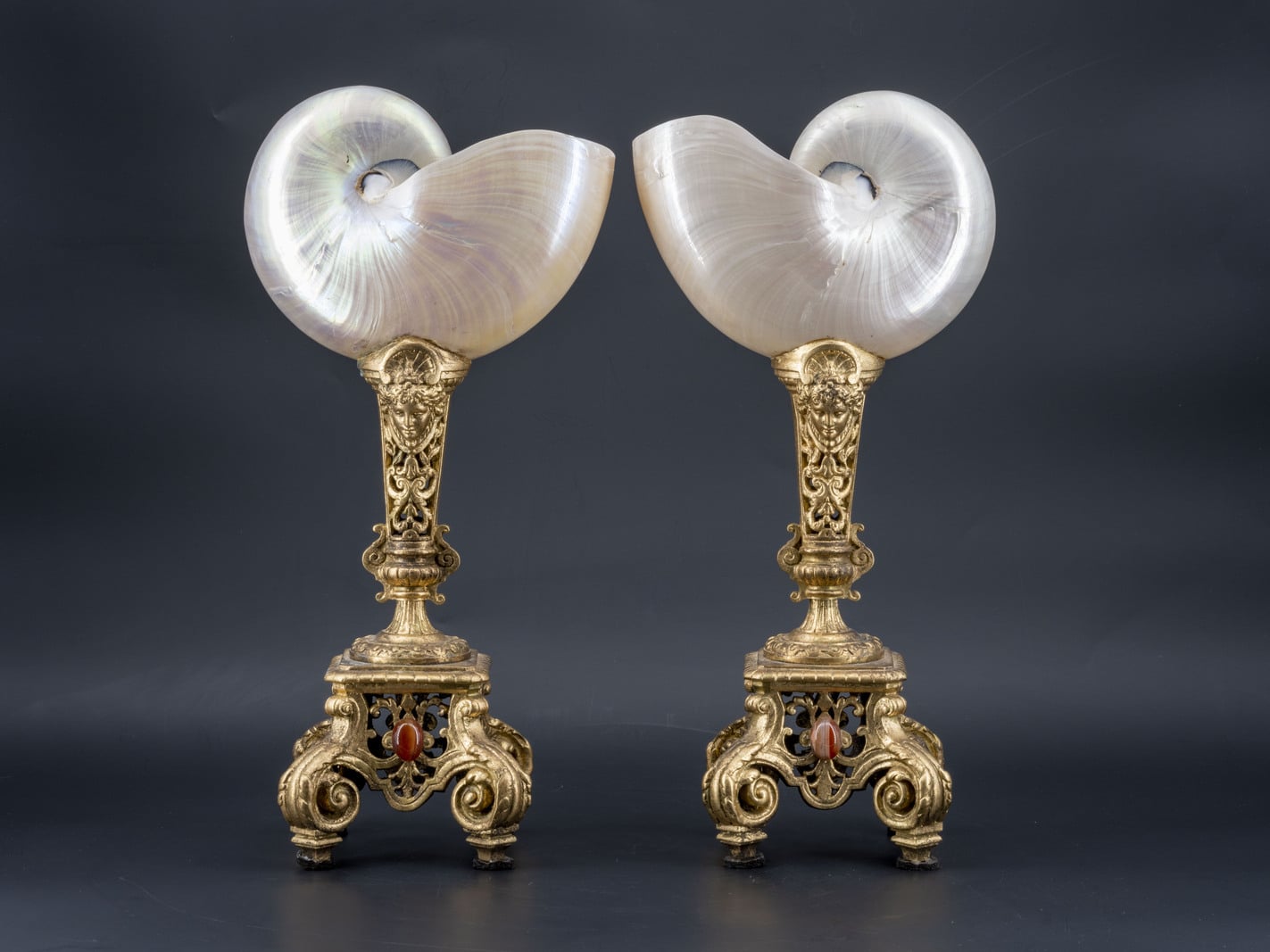
The ornament is then pushed to refinements of an incredible luxury. Goldsmith settings are probably the best known ornaments. Yet they are not always content with gold, silver or vermeil. Sometimes the artists mix in hard or precious stones, sometimes even other fascinating curiosities such as coral.
The surfaces of precious metals are polished, lustrous or dull, playing on contrasts like an echo of the changing reflections of mother-of-pearl. The frames and the feet that support them are the pretext in the 15th and 16th centuries for baroque flights where tritons, dolphins or sirens, allegorical or bizarre characters evoke the real or mythical origins of the nautilus.
Sometimes still, the nautilus is considered for its shape and takes part in a game of heterogeneous recomposition of a creature (often a fantastic animal) or a ship, a souvenir of its journey from the distant Pacific to European cabinets of curiosities. In this exercise, the goldsmith Wenzel Jamnitzer (circa 1507-1585) is undoubtedly the most virtuoso. This mannerist goldsmith and engraver from Vienna practiced for a long time in Nuremberg, where all the greatest German princes solicited him and maintained his position as court goldsmith from reign to reign.

More rarely, it is the very surface of the shell that is the support of the art. The nautilus is engraved with patterns opposing matte to shiny. These works, less ostentatious, are borrowed from a lot of poetry:
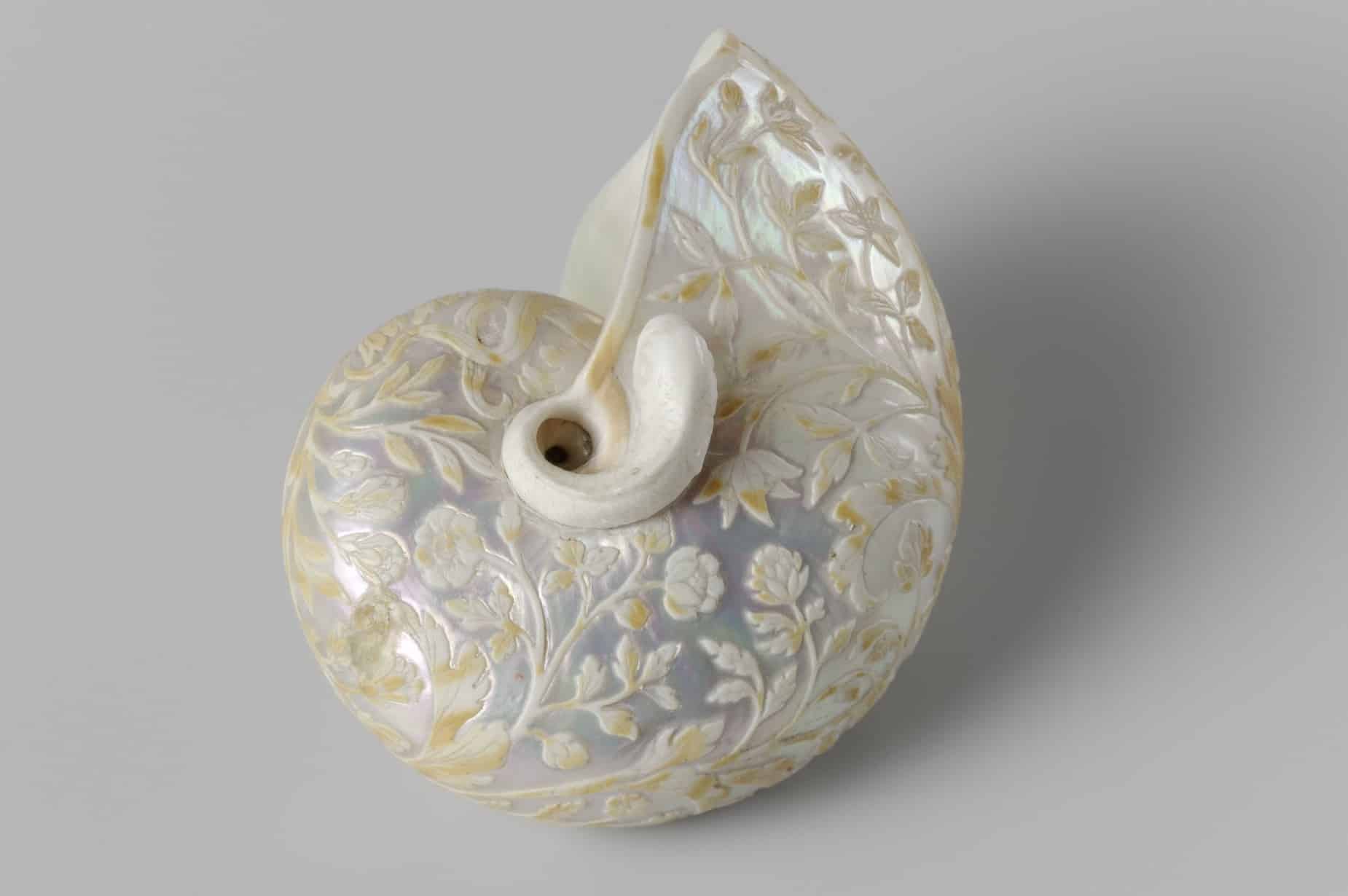
Nautilus: objects of art and study
Specific to Renaissance art, the particular status of these shells intertwines art and scholarship, as a representative synthesis of the humanist spirit of the 15th and 16th centuries. The aesthetic research of goldsmiths takes nothing away from the study of scientists. And, when the still lifes illustrate these cabinets of curiosities which persisted in the 17th century, the spectator is caught up in the naturalistic precision as well as by the fascination that the nautilus exerts on the artist. The translucency of the shell, the complex reflections of the mother-of-pearl are as many exercises of virtuosity for the painter as they arouse the interest of the scientist.
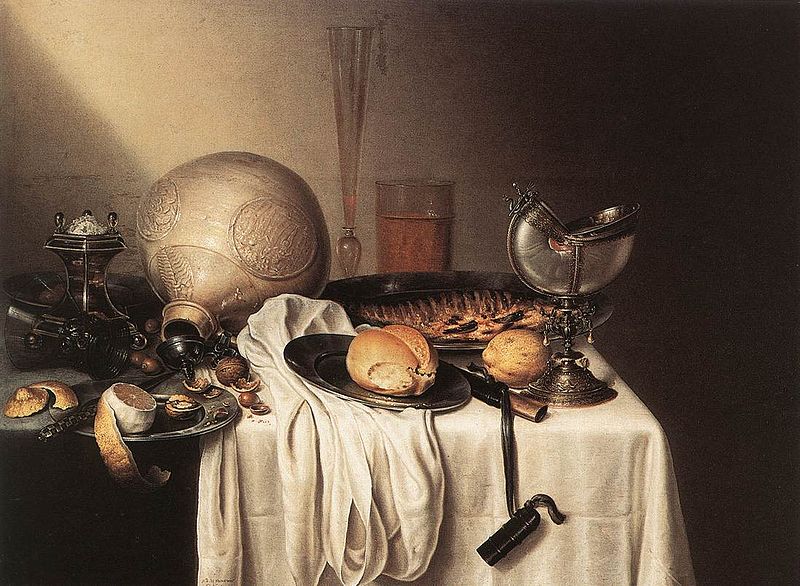
The onset of globalization, the development and technical and scientific progress of the Enlightenment and then the upheaval of the Industrial Revolution in the 19th century will weaken the attraction for cabinets of curiosities which are less and less so. In the 19th century, the bourgeoisie still enjoyed amassing a few collections of naturalia in charming display cases, but this hobby stemmed more from the need to establish a social condition than from a fascination for exotic marvels. From now on, it is a question of accounting for what science has elucidated or else of imitating the habits of the Ancien Régime by accumulating pieces enshrined in goldsmithery. The 20th century will forsake the cabinets of curiosities but will be fascinated by the primitive arts which then have the same exotic and fascinating attraction as the nautiluses in the Renaissance.
Today, if the fashion for cabinets of curiosities resurfaces, it is clear that it is more infatuated with the aesthetic effect of accumulation than with the baroque beauty of unique pieces. Despite this, if fashions pass, the nautiluses engraved, decorated or mounted in goldsmithery remain superb collector’s items always eagerly coveted on the art market.
Marielle Brie
Art Historian for Art Market and Cultural Media
Author of the blog Objets d’Art et d’Histoire
Autres ressources et documentations
28 June 2025
Plaster Sculptures, Plaster Casts
For a long time, plaster casts suffered from a poor reputation. Often regarded as crude replicas, and sometimes even dismissed as inexpensive imitations, they nonetheless had…
17 April 2025
The Middle-Ages Furniture
Rare and highly sought-after, Middle-Ages furniture is making a strong comeback. An overview of this market, where enlisting the guidance of a professional is strongly advisable.
18 March 2025
Murano Glass Furniture
Since the beginning of the 20th century, Murano glassmakers have been exploring new horizons. After classic lighting and decorative art, Murano glass is now used to adorn…
16 December 2024
A bronze triton after the sculptures of François Girardon (1628 – 1715) in Versailles
This fountain element is all the more admirable as it is sculpted after the masterpieces of the Pyramid Basin, on the parterre of the North Wing of the Versailles gardens.
18 November 2024
Tyco Bookcase, by Manfredo Massironi, for Nikol International
A pure creation of optical art research in the 1960s, the Tyco library shelf designed by Manfredo Massironi invites the viewer to bring the work of art to life on a daily basis.
3 August 2024
The Ocean Liner Style
In the 20th century, the immense ocean liners connecting the Old Continent and the New World were ambassadors of tastes and innovations on both sides of the Atlantic.
